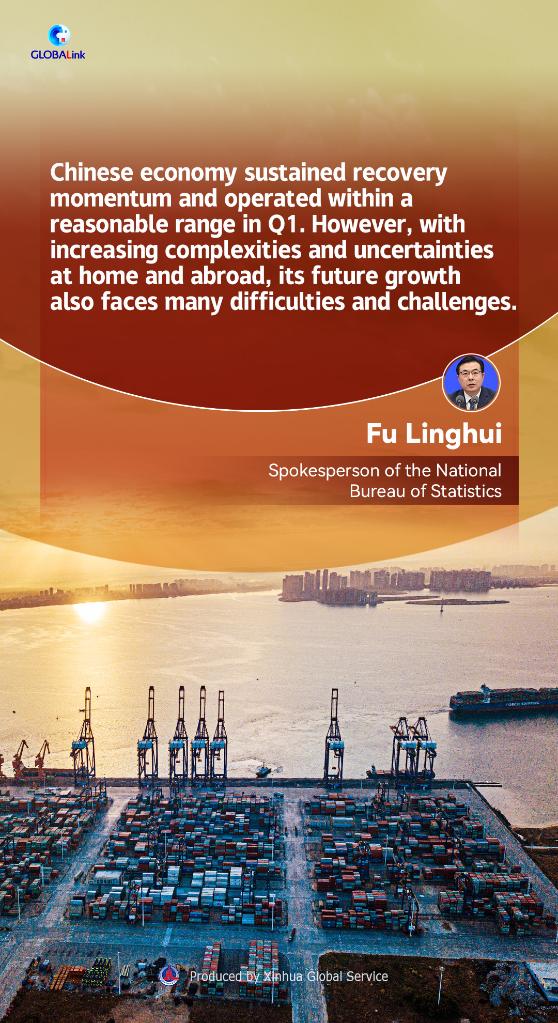China's economy on solid footing despite challenges of COVID, external uncertainty
* China's gross domestic product grew 4.8 percent year on year to 27.02 trillion yuan in the first three months, quickening from a 4-percent increase in the fourth quarter last year.
* China's economy posted a stable performance and continued recovery as the country struck a balance between epidemic control and economic and social development.
* Consumption has been restrained by recent epidemic rebounds but the recovery trend will not change and consumption will continue to function as the "ballast stone" of the economy.
BEIJING, April 18 (Xinhua) -- China's economy got off to a steady start in 2022 in the face of global challenges and a resurgence of COVID-19 cases.
The country's gross domestic product (GDP) grew 4.8 percent year on year to 27.02 trillion yuan (about 4.24 trillion U.S. dollars) in the first three months, quickening from a 4-percent increase in the fourth quarter last year, according to data from the National Bureau of Statistics (NBS) on Monday.
The economy posted a stable performance and continued recovery as China struck a balance between epidemic control and economic and social development, NBS spokesperson Fu Linghui told a press conference.
After a strong rebound in 2021, China witnessed some unexpected challenges at the beginning of this year, with a volatile global situation and multiple, sporadic COVID-19 outbreaks on the domestic front. Downward economic pressure is on the rise and some major indicators have seen slower increases, according to Fu.
"But the long-term economic fundamentals remain sound and the continued momentum of economic recovery has not changed," Fu said, emphasizing that the country is confident and capable of overcoming these difficulties.
A breakdown of Monday's data shows that value-added industrial output posted a stable 6.5-percent increase from a year ago in the first quarter, and fixed-asset investment jumped 9.3 percent. Retail sales of consumer goods went up 3.3 percent.
The surveyed urban unemployment rate stood at 5.5 percent in January-March, with 2.85 million new urban jobs created in this period.

BRAVING CHALLENGES
As the Omicron variant has infected over 320,000 people across China since March, a wide range of contact-based sectors from catering to retail have taken a major hit.
In some instances the severity of the situation had surpassed expectations, Fu said, acknowledging that in some hard-hit areas factory production was reduced or suspended and logistics curbed.
But the spokesperson noted China's targeted, effective epidemic controls will minimize the impact of COVID-19 on the economy. He added that a string of recently unveiled pro-growth measures will help businesses and stabilize the economy.
The central bank announced Friday a cut of 0.25 percentage points in the cash amount banks must hold in reserve. Designed to support the real economy, the move is expected to free up 530 billion yuan in long-term liquidity.
Centrally administered state-owned enterprises have promised to exempt three to six months' rent for small businesses in the service industry. Tax authorities nationwide in March deferred 256.7 billion yuan of tax payments for micro, small and medium enterprises in the manufacturing sector.
Most recently, at a national teleconference Monday, Chinese Vice Premier Liu He underlined efforts to eliminate obstacles to goods flows across the nation, including creating a "white list" of foreign trade firms and companies in the automobile, medical and other key sectors.
Thanks to the prompt actions, Fu said the industrial production largely remained stable in the first quarter and showed strong resilience.
The production of new energy vehicles, solar panels and industrial robots went up 140.8 percent, 24.3 percent and 10.2 percent, respectively. The output of the high-tech manufacturing sector expanded 14.2 percent, much higher than the industrial average.

HARD BUT ATTAINABLE
China's policymakers set the full-year growth target at 5.5 percent in March, which, given increasing economic headwinds, is still attainable but requires greater efforts, analysts said.
At the press conference, Fu pledged stronger economic and industrial support, especially for manufacturing, micro and small enterprises as well as those hit hardest amid the epidemic. He noted that actions will be taken to ensure energy and raw material supplies and stabilize industrial and supply chains.
The authorities are pushing forward a mass campaign to reduce taxes and fees worth 2.5 trillion yuan this year, which will benefit numerous enterprises, in particular small firms.

Vehicles under production are transferred through the office area at the Tiexi Plant of BMW Brilliance Automotive (BBA) in Shenyang, northeast China's Liaoning Province, Feb. 16, 2022. (Xinhua/Yang Qing)
Looking into the full year, the spokesperson expressed confidence in the economy, citing favorable conditions including reviving consumption, stronger investment, and innovation-driven industrial upgrades.
Consumption has been restrained by recent epidemic rebounds but the recovery trend will not change and consumption will continue to function as the "ballast stone" of the economy, he said. Final consumption contributed 69.4 percent to GDP expansion in the first quarter, while investment and exports made up 26.9 percent and 3.7 percent, respectively.
Yi David Wang, chief China economist at Credit Suisse Group AG, has recently predicted China's GDP can grow 5.9 percent in 2022, driven in part by less-impacted consumption, strong government and corporate investment, and housing investment.
Photos
Related Stories
- Interview: China's economy has huge potential, says U.S. scholar
- China's gross ocean product hits 9 trillion yuan for first time
- Chinese premier stresses promoting consumption to stabilize economic fundamentals
- Americans' dim view of economy could bode ill for Democrats
- Chinese premier calls for stabilization of employment, prices to shore up economy
Copyright © 2022 People's Daily Online. All Rights Reserved.










